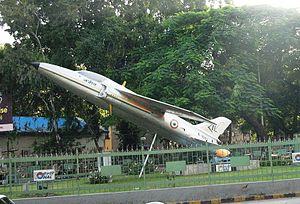HAL Ajeet
| Hindustan Aeronautics Ajeet | |
|---|---|
 Ajeet prototype E1083 in front of the HAL headquarters in Bangalore |
|
| Type: | Fighter plane |
| Design country: | |
| Manufacturer: | |
| First flight: |
1976 |
| Commissioning: |
1977 |
| Number of pieces: |
89 (including 10 converted Folland Gnats) |
The HAL Ajeet ( Sanskrit : अजित, for invincible ) was a further development of the British Folland Gnat , which was built under license in India by Hindustan Aeronautics Limited .
construction and development
The Indian Air Force (IAF) flew the Folland Gnat from 1958 to 1974, with over 200 aircraft manufactured under license from Hindustan Aeronautics Limited (HAL) under the name Ajeet. The aircraft type was very successful in both wars with Pakistan in 1965 and 1971 . The Gnat was used both to achieve superiority in the air at low altitudes and for close air support . The Gnat was inexpensive to build and maintain, but its systems were unreliable, especially the control systems, and it was difficult to maintain. For this reason, the Indian Air Force requested an improvement in the type in 1972. Although the original requirement was for an interceptor , it was later revised to include the secondary requirement of close air support capability.
The changes to Gnat were significant and included:
- Improved hydraulics and control systems (these were the reasons for many of the Gnat complications).
- Installation of improved Martin-Baker GF4 ejection seats
- Modernized avionics .
- Changed tail units
- Improvements to the chassis .
- Installation of internal tanks to free the external load stations for additional weapon loads
- Installation of two additional external load stations
The last two gnats manufactured by Hindustan Aeronautics Limited were modified as prototypes for the Ajeet. The first aircraft modified in this way flew on March 6, 1975, the second followed on November 5. The tests were successful, so that series production began immediately and the first Ajeet made its maiden flight on September 30, 1976. Outwardly, the Ajeet looks very similar to the Gnat, the only obvious differences to the previous model are the two additional external load stations.
The Ajeet entered service in 1977 and withdrawn in 1991. Therefore, there was never an active combat mission.
HAL started an internal project for a training aircraft to be built on the Ajeet and delivered the first prototype in 1982. However, this was lost in an accident that same year. Two more prototypes were completed, but the lack of interest from the government and the impending decommissioning of the Ajeet led to the program being canceled. However, the two prototypes were handed over to the unit that also flew the Ajeet and served there until it was replaced by the MiG-27M Bahadur in 1991.
Versions
- Gnat Mk 2 : Original name of the Indian Air Force for the Ajeet Mk 1
- Ajeet Mk 1 : Single-seat ground attack and fighter aircraft
- Ajeet Mk 2 Trainer : Two-seat prototype of an advanced training aircraft
use
Technical specifications
| Parameter | Data |
|---|---|
| Type | single-seat fighter-bomber / interceptor |
| span | 6.73 m |
| length | 9.04 m |
| height | 2.46 m |
| Wing area | 12.69 m² |
| Elongation | 3.56 |
| drive | Bristol-Siddeley Orpheus 701-01 with 20 kN thrust |
| Top speed | 1,152 km / h |
| Use radius | 172 km |
| Empty mass | 2,307 kg |
| Max. Takeoff mass | 4,173 kg |
Armament
- two Aden 30mm cannons
- four external load stations under the wings for various types of weapons up to 900 kg total mass